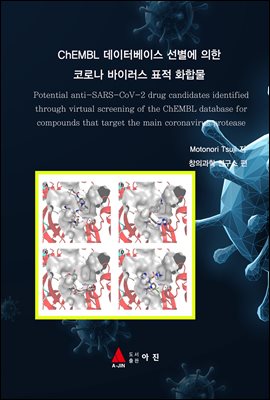
CheEMBL 데이터베이스 선별에 의한 코로나 바이러스 표적 화합물
- 저자Motonori Tsuji 저
- 출판사아진
- 출판일2020-07-12
- 등록일2020-12-21
- SNS공유


- 파일포맷PDF
- 파일크기9MB
- 공급사YES24
-
지원기기
PC
PHONE
TABLET
프로그램 수동설치
전자책 프로그램 수동설치 안내
아이폰, 아이패드, 안드로이드폰, 태블릿,
보유 1, 대출 0,
예약 0, 누적대출 7, 누적예약 0
책소개
A novel coronavirus [severe acute respiratory syndrome coronavirus 2(SARS-CoV-2), or 2019 novel coronavirus] has been identified as the pathogen of
coronavirus disease 2019. The main protease(Mpro, also called 3-chymotrypsin-like
protease) of SARS-CoV-2 is a potential target for treatment of COVID-19. A Mpro
homodimer structure suitable for docking simulations was prepared using a crystal
structure (PDB ID: 6Y2G; resolution 2.20 A). Structural refinement was performed
in the presence of peptidomimetic a-ketoamide inhibitors, which were previously
disconnected from each Cys145 of the Mpro homodimer, and energy calculations
were performed. Structure-based virtual screenings were performed using the
ChEMBL database. Through a total of 1 485 144 screenings, 64 potential drugs (11
approved, 14 clinical, and 39 preclinical drugs) were predicted to show high binding
affinity with Mpro. Additional docking simulations for predicted compounds with
high binding affinity with Mpro suggested that 28 bioactive compounds may have
potential as effective anti-SARS-CoV-2 drug candidates. The procedure used in
this study is a possible strategy for discovering anti-SARS-CoV-2 drugs from
drug libraries that may significantly shorten the clinical development period with
regard to drug repositioning.
목차
제 1편 코로나바이러스 정의1. 코로나바이러스감염증-19(Covid-19) 정보 7
2. 코로나바이러스 분류 및 특성 9
3. 코로나 바이러스 전자현미경 형태 11
4. 코로나바이러스 구조 (Covid-19 Organization) 13
5. 코로나19: 환경에 지속적인 영향을 미칠까? 19
6. 치료법(Therapeutical Method) 22
제 2편 연구논문
Potential anti-SARS-CoV-2 drug candidates identified through virtual
screening of the ChEMBL database for compounds that target the
main coronavirus protease
1. Abstract 23
2. Introduction 23
3. Methods 24
4. Preparation of 3D structures from the ChEMBL database 24
5. Additional docking simulations for hit compounds 25
6. Results and Discussion 25
7. Conclusions 31
8. References 31

















